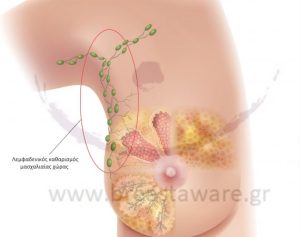
What is Axillary Lymph Node Dissection?
The armpit lymph node cleaning is a surgical procedure performed on patients with breast cancer when there is a documented or high probability metastasis to the axillary lymph nodes. During the operation, the axillary lymph nodes (usually 10-40) are removed in order to examine them microscopically for cancer cells.
The operation is usually performed at the same time as the lumpectomy or the mastectomy, in order to collect valuable information about the forecast and to form the appropriate complementary treatment plan (chemotherapy, radiotherapy).
When is Axillary Lymph Node Dissection Necessary?
Axillary lymph node dissection is required in the following cases:
- Diagnosed lymph node metastasis before surgery, either with imaging findings (ultrasound) or with biopsy
- More than two positive sentinel lymph nodes
- Failure to identify the sentinel lymph node during surgery
- Inflammatory breast cancer, where the disease is locally more aggressive
- Positive sentinel lymph node after neoadjuvant chemotherapy (NACT)
According to the latest guidelines (ASCO, ESMO), the use of lymph node dissection is limited to selected cases to avoid unnecessary burden for the patient.
Complications of Axillary Lymph Node Dissection
Although lymph node cleaning is often necessary, it is not without complications. These can occur both immediately and over time. They include:
- Infection or hematoma at the surgical site
- Seroma, i.e. collection of fluid under the skin
- Loss of sensation or muscular dyskinesia at the upper end
- Chronic pain in the area
- Lymphedema, swelling of the arm due to disrupted lymphatic drainage (occurs in about 20% of cases)
Proper patient education, physiotherapy, and preventive measures are essential to manage these complications and improve quality of life.
In summary
Axillary lymph node dissection is an important tool in surgical treatment of breast cancer, especially when they exist metastatic lymph nodes. Despite the risk of complications, it offers valuable information for staging and determining treatment.
At breastaware.gr you will find reliable, scientifically validated information on all aspects of breast cancer in clear and friendly language. Our goal is to empower every woman through knowledge.
Bibliography:
- Caudle, A. S., et al. (2020). American Society of Clinical Oncology (ASCO) guideline update: Axillary surgery in the management of breast cancer. Journal of Clinical Oncology, 38(24), 2635-2648.
- Cardoso, F., et al. (2019). ESMO Clinical Practice Guidelines for diagnosis, treatment and follow-up: Early breast cancer. Annals of Oncology, 30(8), 1194-1220.
- Galimberti, V., et al. (2021). Axillary surgery in breast cancer: an update on recent trials and future directions. Breast, 60, 1-8.
- Zhou, Y., et al. (2023). Incidence and risk factors of lymphedema following axillary lymph node dissection: A meta-analysis. Breast Cancer Research and Treatment, 200(1), 1–10..
- van Roozendaal, L. M. T., et al. (2020). Regional nodal irradiation versus axillary lymph node dissection after neoadjuvant chemotherapy in node-positive breast cancer (NSABP B-51/RTOG 1304). Lancet Oncology, 21(2), 202–214..
